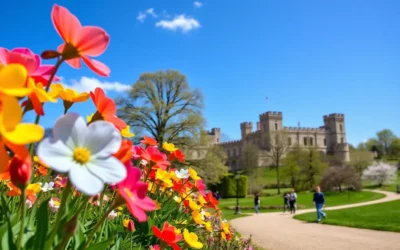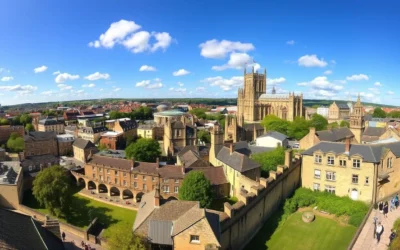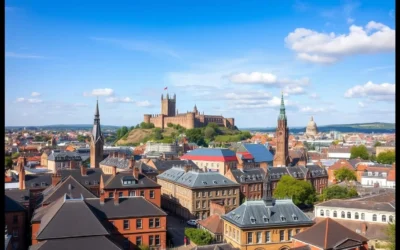Did you know that Durham Cathedral was used as a filming location for Hogwarts in the Harry Potter films? This UNESCO World Heritage site is just one of many treasures waiting to be discovered in this compact yet captivating English city. Nestled within a dramatic loop of the River Wear, Durham combines 1,000 years of history with stunning landscapes, vibrant culture, and unexpected coastal delights—all within a single county that locals proudly call “the Land of the Prince Bishops.”
Getting There & Planning Your Journey
Durham is exceptionally well-connected by rail, making it an easy addition to any UK itinerary. The city sits on the East Coast Main Line, with direct trains from London King’s Cross (3 hours), Edinburgh (1 hour 45 minutes), and Manchester (2 hours 15 minutes). The Durham train station is perched above the city, offering dramatic views as you arrive.
If you’re flying into the UK, Newcastle International Airport is the closest option, just 30 km (19 miles) north of Durham. From there, you can take a metro to Newcastle Central Station and connect to a train for the 15-minute journey to Durham.
Ready to Book Your Trip to Durham?
Find the best flight deals to nearby Newcastle or direct trains to Durham from major UK cities.
For those driving, Durham is accessible via the A1(M) motorway. However, the city center has limited parking and several one-way streets, so consider using the Park and Ride services located on the outskirts of the city.

Best Time to Visit & Weather Tips
Durham experiences the typical British climate of mild summers and cool winters, with rainfall possible throughout the year. For the most pleasant experience, consider these seasonal highlights:
Recommended Times to Visit
- Late Spring (May-June): Comfortable temperatures around 15-18°C (59-64°F) with blooming gardens and longer daylight hours.
- Summer (July-August): Peak tourist season with temperatures averaging 19-21°C (66-70°F). Perfect for riverside walks and outdoor activities.
- Early Autumn (September-October): Beautiful fall colors in Durham’s woodlands and fewer crowds. Temperatures range from 11-17°C (52-63°F).
Times to Avoid
- Winter (December-February): Short daylight hours and temperatures between 1-7°C (34-45°F). Some attractions have reduced hours.
- University Term Time: Accommodation prices can increase when Durham University is in session (October-December, January-March, April-June).
- November: Typically the rainiest month with grey skies, though the biennial Lumiere Festival (held in odd-numbered years) makes this month worth considering despite the weather.
Always pack layers and a waterproof jacket regardless of when you visit—Durham’s weather can be unpredictable, and rain showers can occur even during summer months.

Getting Around Locally
Durham’s compact city center is perfect for exploring on foot, with most major attractions within a 15-minute walk of each other. The city is built on a hill, so be prepared for some steep climbs, particularly when walking up from the riverside to the cathedral and castle.
Visitor Tip: “The steepest climb is Silver Street, locally known as ‘cardiac hill.’ Take it slow or use the Cathedral Bus if mobility is a concern.” – A visitor from Australia
For those who prefer not to tackle the hills, the Cathedral Bus runs every 20 minutes between the Market Place and the Cathedral. Local buses also connect the city center with outlying attractions like Beamish Museum and the Durham Heritage Coast.
To explore the wider County Durham area, including coastal towns like Seaham or countryside attractions like High Force waterfall, you’ll need either a car or to use the regional bus network. The Arriva North East app is helpful for planning bus journeys.
Explore Durham at Your Own Pace
For maximum flexibility to visit coastal towns and countryside attractions, consider renting a car during your stay.
Where to Stay
Durham offers accommodation options ranging from luxury hotels to cozy B&Bs. Here are the best areas to stay based on your preferences:
City Center
Perfect for first-time visitors who want to be within walking distance of the cathedral, castle, and restaurants. Options include:
- Forty Winks Guest House: Quirky yet stylish boutique accommodation steps from the cathedral.
- Hotel Indigo Durham: Housed in a beautiful Victorian-era building that was once the city’s council offices.
Riverside
Ideal for those seeking scenic views and a quieter atmosphere while still being close to attractions:
- Durham Marriott Hotel Royal County: Historic hotel with river views and a terrace.
- Radisson Blu Durham: Modern hotel with riverside location and spa facilities.
Coastal & Countryside
Perfect for travelers looking to combine city exploration with rural or coastal experiences:
- Seaham Hall: Luxury spa hotel on Durham’s heritage coast, perfect for a pampering break.
- High Force Hotel: Former shooting inn near the famous High Force waterfall in the Durham Dales.
“We stayed at Seaham Hall for two nights and it was exceptional. The spa facilities are world-class and the views of the Durham Heritage Coast are breathtaking. Worth every penny for a special occasion.”
Find Your Perfect Durham Accommodation
From historic city center hotels to coastal luxury retreats, book your ideal stay now.

Dining & Local Cuisine
Durham’s food scene blends traditional North East English fare with contemporary cuisine. The city’s status as a university town ensures a diverse range of dining options to suit all budgets.
Must-Try Local Specialties
- Pan Haggerty: A hearty dish of sliced potatoes, onions, and cheese baked together—perfect comfort food after a day of sightseeing.
- Durham Lamb: Locally raised lamb often served with mint sauce and seasonal vegetables.
- Stottie Cake: A flat, round bread roll unique to North East England, traditionally filled with ham or cheese.
- Durham Gin: Locally distilled gin featuring botanicals from the region—available in many pubs and restaurants.
Top Dining Spots
City Center Gems
- Flat White Kitchen: A popular café spread across multiple floors of a historic townhouse, known for exceptional brunch options and coffee.
- The Cellar Door: Housed in a 13th-century building near the cathedral, specializing in local seafood and British classics with a modern twist.
- Cosy Club: Stylish restaurant with balcony seating offering views of the cathedral and river—great for cocktails and tapas.
Worth the Journey
- Seaham Hall Dining Room: Fine dining restaurant within the luxury hotel, focusing on seasonal and locally sourced ingredients.
- High Force Hotel Restaurant: Traditional pub fare with a gourmet touch, perfect after exploring the nearby waterfall.
- Beamish Museum Tearooms: Experience authentic period recipes in historic settings throughout the museum.
Food Tour Tip: Triple A Food Tours offers guided culinary experiences through Durham, combining sightseeing with stops at top eateries. Tours typically include five food stops and last around 3 hours—a perfect introduction to the local food scene.

Attractions, Sightseeing & Activities
Must-See Historic Sites
Durham Cathedral
This magnificent Norman structure is widely considered one of the finest examples of Romanesque architecture in Europe. Don’t miss:
- The Cloisters (featured in Harry Potter films as Hogwarts)
- The Shrine of St. Cuthbert
- The tomb of the Venerable Bede
- The cathedral’s treasury, housing medieval artifacts
- The 66 m (217 ft) central tower, offering panoramic views (when open for climbing)
Durham Castle
Built in 1072 by William the Conqueror, the castle now serves as part of Durham University. Access is by guided tour only, which includes:
- The Great Hall with its impressive wooden ceiling
- The Norman Chapel dating from the 11th century
- The Black Staircase, a 17th-century architectural marvel
- The castle’s collection of historic armor and paintings

Riverside Experiences
The River Wear loops around the Durham peninsula, creating a natural moat around the cathedral and castle. This picturesque setting offers several ways to enjoy the water:
- Durham Riverside Walk: A 3 km (1.9 mile) circular route taking approximately 1-1.5 hours, offering stunning views of the cathedral from multiple angles.
- Traditional Rowing Boats: Available for hire from Brown’s Boathouse from April to October, allowing you to row beneath the city’s historic bridges.
- Prince Bishop River Cruiser: One-hour guided cruises providing historical commentary and unique perspectives of the city from the water.
- Paddleboarding: For the more adventurous, Adventure Access offers guided paddleboarding sessions on the River Wear.
Experience Durham’s Top Attractions
Book guided tours, river cruises, and unique experiences to make the most of your visit.
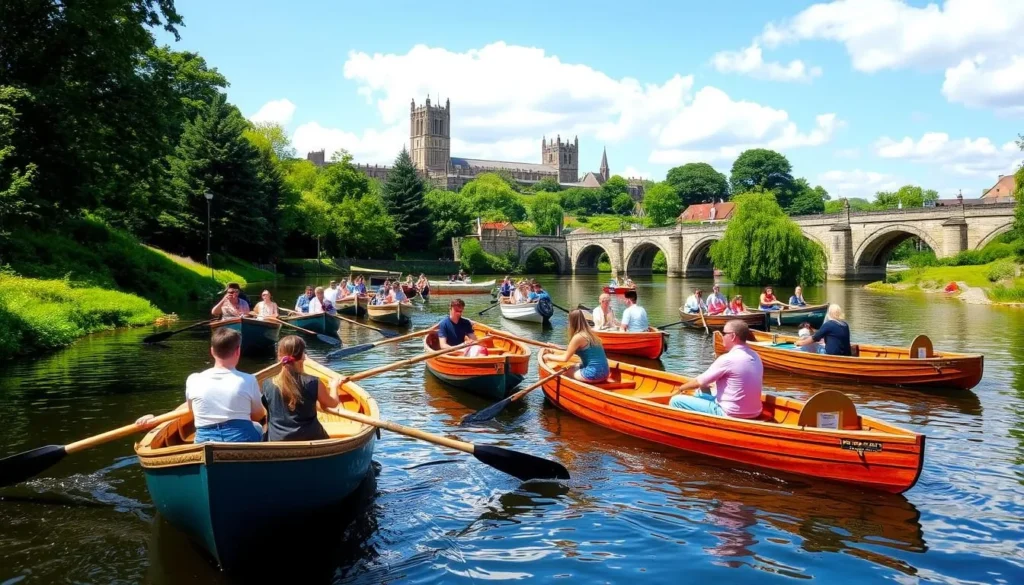
Museums, Cultural Spots & Festivals
Museums & Galleries
- Oriental Museum: Housing over 36,000 artifacts from across Asia, this Durham University museum is particularly known for its Egyptian and Chinese collections.
- Durham Museum and Heritage Centre: Located in a historic church, this small museum tells the story of Durham’s development through the centuries.
- Palace Green Library: Home to the Museum of Archaeology and special exhibitions focusing on Durham’s history.
- Beamish Museum: Located 14 km (8.7 miles) from Durham city center, this open-air living museum recreates life in North East England during the 1820s, 1900s, and 1940s.
Annual Festivals & Events
Lumiere Festival
The UK’s largest light festival transforms Durham every two years (odd-numbered years) in November. Buildings, bridges, and public spaces become canvases for spectacular light installations by international artists.
Durham Book Festival
Held each October, this literary celebration brings authors, poets, and thinkers to venues across the city for readings, workshops, and discussions.
Durham Miners’ Gala
Known locally as “The Big Meeting,” this July event celebrates the region’s mining heritage with brass bands, banner parades, and speeches.
Durham Regatta
Often called “the Henley of the North,” this June rowing event has been held on the River Wear since 1834.
“The Lumiere Festival completely transformed Durham. Seeing the cathedral illuminated with colorful projections while walking through the medieval streets was magical—like stepping into another world.”

Sports, Nature & Outdoor Experiences
Durham Heritage Coast
Just 14 km (8.7 miles) east of Durham city lies a dramatic coastline that has been transformed from its industrial past into a place of natural beauty:
- Durham Coastal Footpath: An 11-mile walking route stretching from Seaham to Crimdon, featuring dramatic limestone cliffs and secluded coves.
- Seaham Beach: Famous for its sea glass—smoothed fragments from the former Londonderry Bottleworks that wash up on the shore.
- Nose’s Point: A former colliery site now reclaimed by nature, offering spectacular views along the coastline.
- Hawthorn Dene: A steep-sided wooded ravine that cuts through the limestone cliffs down to the shore.
Durham Dales & Countryside
The western part of County Durham encompasses part of the North Pennines Area of Outstanding Natural Beauty:
- High Force Waterfall: England’s largest waterfall by volume, where the River Tees drops 21 m (69 ft) into a plunge pool below.
- Low Force: A series of smaller falls downstream from High Force, accessible via a suspension bridge.
- Hamsterley Forest: Durham’s largest forest with walking trails, mountain biking routes, and wildlife spotting opportunities.
- Raby Castle: Set in 200 acres of deer park, this medieval castle offers both historical interest and beautiful grounds for walking.
Outdoor Activity Tip: For a unique perspective of Durham’s countryside, consider booking a guided e-bike tour through the Durham Dales. The electric assistance makes the hills manageable for most fitness levels while allowing you to cover more ground than walking.

Safety, Etiquette & Local Customs
Durham is generally a safe destination with low crime rates, but as with any travel destination, it’s wise to take standard precautions:
Safety Tips
- The city center is well-lit and patrolled, but take normal precautions at night, especially around the riverside paths which can be dark.
- The River Wear can have strong currents—if rowing or paddleboarding, follow safety instructions carefully.
- Durham’s hills can be steep and cobbled streets can be slippery when wet—wear appropriate footwear.
- If exploring the Durham Heritage Coast, check tide times and stay away from the base of cliffs which can be unstable.
Local Etiquette
- Durham Cathedral is an active place of worship—observe quiet during services and respect photography restrictions in certain areas.
- Durham University occupies many historic buildings in the city—be mindful that these are working educational spaces, not just tourist attractions.
- The North East of England is known for its friendly locals—don’t be surprised if strangers strike up conversations in pubs or cafes.
- Tipping in restaurants is customary (10-15%) but not mandatory as it is in some countries.
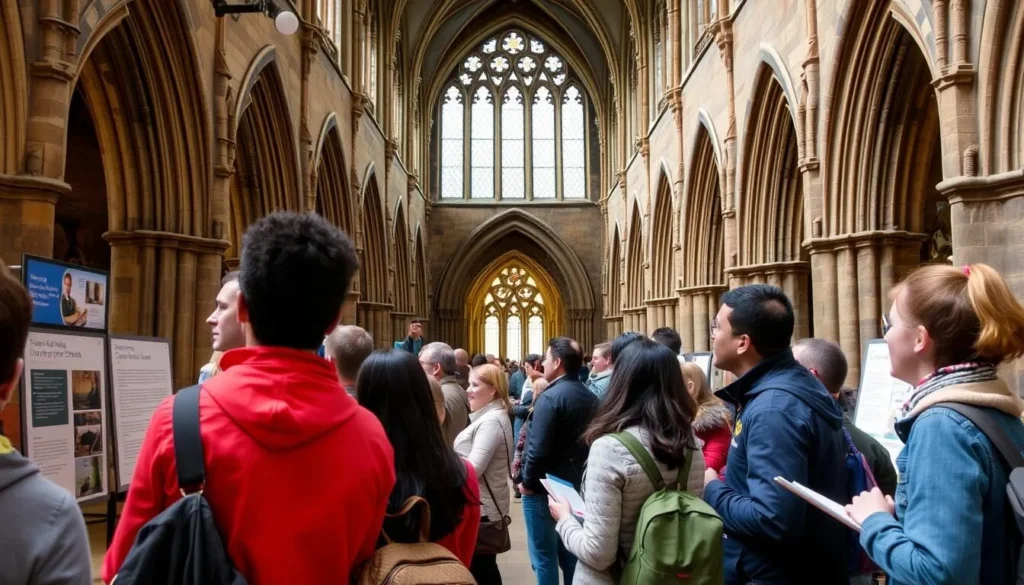
Visitor Comments About Durham
“We only planned a day trip to Durham but wished we’d stayed longer. The cathedral alone deserves several hours, and the riverside walks are so peaceful. Don’t rush your visit—this small city has so much depth.”
“The Durham Heritage Coast was an unexpected highlight of our trip. Collecting sea glass at Seaham Beach became a favorite memory for our children, and the coastal path offered stunning views. A hidden gem that deserves more recognition.”
“As a history buff, I found Durham fascinating. The Prince Bishops had almost regal powers, and this legacy is visible throughout the city. The guided tour of the castle was excellent—our student guide was knowledgeable and entertaining.”

Practical Travel Tips
Money Matters
- ATMs are readily available throughout Durham city center.
- Most establishments accept credit cards, but smaller shops and market vendors may prefer cash.
- The currency is the British Pound (£). If you’re visiting from the Eurozone, you’ll need to exchange currency.
- Durham is generally less expensive than London or Edinburgh, offering good value for accommodation and dining.
Connectivity
- Free Wi-Fi is available in most cafes, restaurants, and hotels.
- The Durham City Free Wi-Fi network covers much of the city center.
- Mobile coverage is generally good, though signal can be patchy in rural parts of County Durham.
- Consider downloading offline maps before exploring the countryside or coastal areas.
Time-Saving Tips
- Visit Durham Cathedral early in the morning to avoid tour groups.
- Purchase Beamish Museum tickets online in advance—they’re valid for a full year of return visits.
- If driving, use the Park and Ride services rather than searching for city center parking.
- Consider a weekday visit if possible—weekends can be busy, especially during summer months.
Accessibility Note: Durham’s historic nature means steep hills and cobbled streets in the city center. The Cathedral Bus provides an accessible alternative for reaching the cathedral and castle. Many attractions, including Durham Cathedral, have made significant improvements to accessibility in recent years, with ramps, elevators, and accessible toilets available.
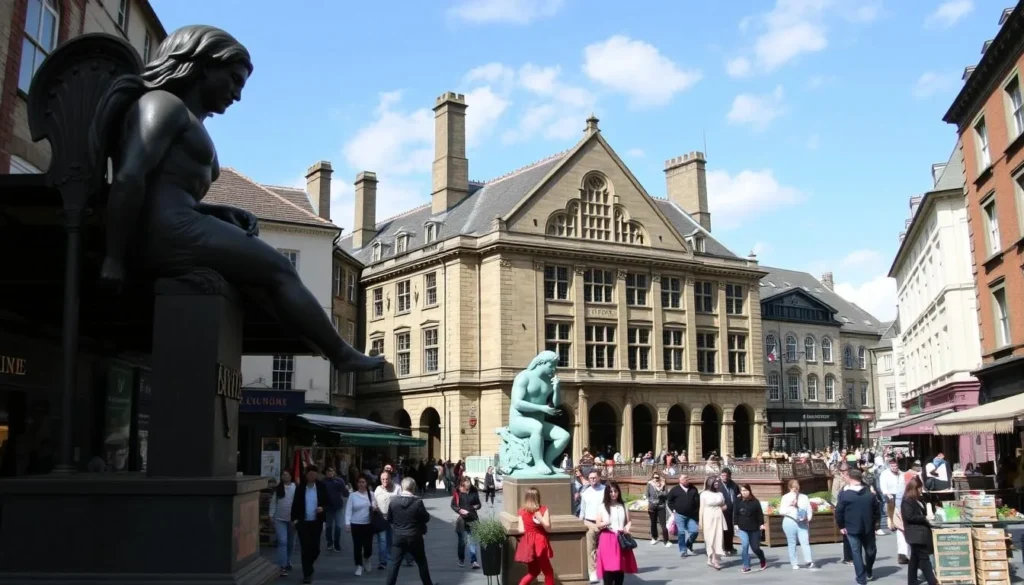
Ready to Discover Durham?
From the awe-inspiring Norman architecture of its UNESCO World Heritage cathedral to the unexpected treasures of its transformed heritage coastline, Durham offers a perfect blend of history, culture, and natural beauty. Whether you’re tracing the footsteps of medieval monks, collecting sea glass on Seaham Beach, or enjoying a traditional meal in a riverside restaurant, this compact yet captivating destination rewards those who take the time to explore its many layers.
Durham may not always feature on the typical UK tourist trail, but those who venture to this northern gem often find themselves planning a return visit before they’ve even left. With its walkable city center, dramatic landscapes, and genuine local welcome, Durham offers an authentic slice of English heritage without the crowds of more famous destinations.
Plan Your Durham Adventure Today
Find flights, accommodation, and experiences to create your perfect Durham itinerary.
The above is subject to change.
Check back often to TRAVEL.COM for the latest travel tips and deals.

